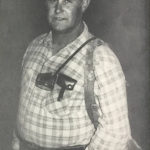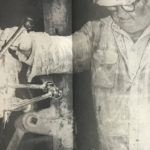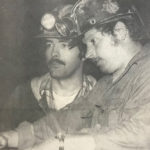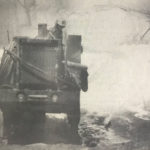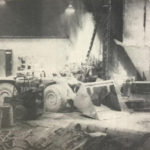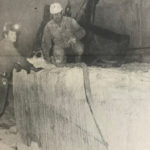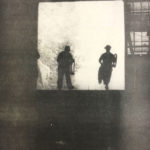By Charles Leave
Start with the statistics: The Danby Quarry covers 19 acres, all of it underground; it has been in operation since 1903, at one time employed close to 300 workers, ships out 200,000 cubic feet (36 million pounds) of marble a year; has a constant temperature range of 47 to 51 degrees, regardless of the outside weather, and a humidity level of 97 percent. The airshaft into the quarry is 468 feet long, seven feet wide and ten feet across. It was made by blasting from the bottom up.
From the entrance to the end of the quarry tunnel is 2,600 feet long and wide enough in places for two tractor trailer rigs to pass each other. The ceiling is as high as 80 feet, as low as five or six feet. The special forklifts used to lift the marble blocks can carry as much as 40 tons. More than a semi-trailer can carry. Each year the quarry supplies Arlington National Cemetery with over 10,000 headstones. Danby Imperial marble is among the purest, whitest marble in the world. It is the largest underground marble quarry in the world.
Given all of that, the quarry is still a mystery to most people. There’s no conscious decision to hide it or anything like that, it’s just that the quarry doesn’t go out of its way to advertise itself. The marble, yes, the quarry, no. For one thing, it’s tucked quite a ways up a hillside in Danby. There’s a long private road (lined on one side with marble chips from the quarry) that leads up to a huge garage door. From there a steep (10 percent grade) road goes down into the quarry. If you’re inside, company policy and federal law dictates that you wear a hard hat with a light, a personal rescuer that can, in the event of a fire underground, keep you alive for up to an hour, and a heavy leather belt to hold it all. This is not the place for a casual tour.
The marble at the Danby Quarry comes in layers, like a wedding cake, nine layers in all, the bottom layer being Danby Imperial. The days when hundreds of workers swarmed around the quarry are long past. Modern technology has reduced the number to 18, on two shifts. The first shift is on from 7 a.m. to 3 p.m. The second shift works from 3 p.m. until midnight. Compressed air and hydraulics are used extensively, with special, giant hammers bigger than the average backhoe, but built low to the ground – low profile – so they can reach into tight spots. As more marble is taken out of the ground, more new marble is blasted and cut free. Still, because of the density of marble (a cubic foot weighs 180 pounds) a 30 ton block is not as big as it sounds. For reference it’s about the size of a VW Bug, squared of at the corners.
Another remarkable thing about the quarry is the work history of the crew. The employee with the least seniority still has half a dozen years on the job, and some, like Leo Wells, are into their third decade. And many of them are following their fathers and grandfathers and older brothers into the trade. When asked where the men learn about the business, Mike Blair, the quarry manager, responded by saying, “They learn it at the supper table, I suppose, hearing their fathers talk about it.”
